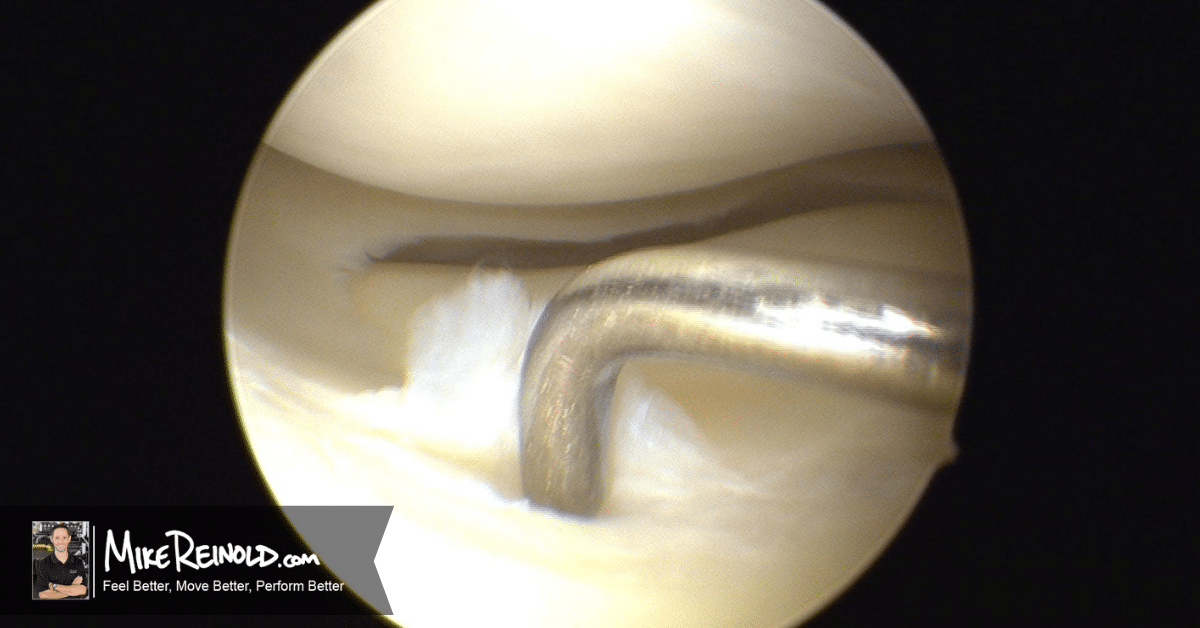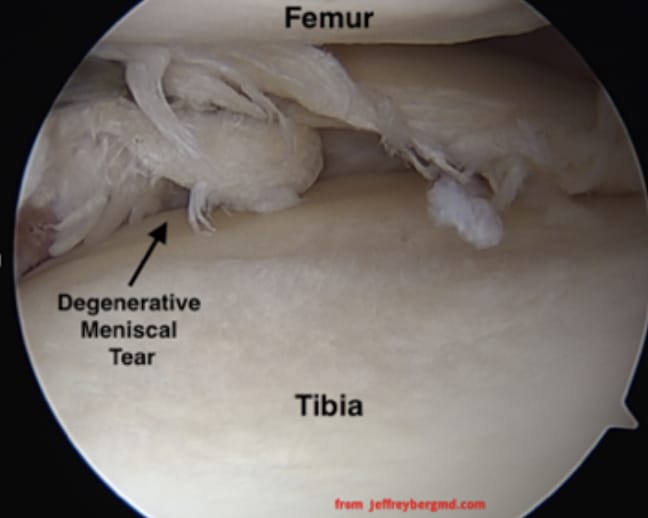Today’s article is a guest post from Lenny Macrina, my co-owner of Champion and co-author of my online knee course. Meniscal tears are common, and some interesting new studies are coming out showing that surgery may not be the best option, at least for some people. Social media is quick to shun meniscus tear surgery, however there are likely still some people that will benefit from this more than physical therapy alone. Lenny discusses more in the article below. But I also wanted to make sure you knew that Lenny and I’s online course on the Evaluation and Treatment of the Knee is on sale this week for 50% off. More info below!
Meniscus tears are very commonly diagnosed by physical therapists and doctors. The question remains, what is the best treatment for someone with a meniscus tear…surgery or physical therapy?
I may be a bit biased because I am a physical therapist. Let me get that out there right now. I’d almost always advocate for physical therapy over surgery for most of the cases that I deal with. But I do believe we are trying to be too black and white at times and need to keep an open mind.
There are many factors that need to be considered when deciding between physical therapy or surgery for a meniscus tear. Some people may do better with physical therapy, while others may do better with meniscal tear surgery.
It depends.
With that, I decided to do a literature to see what the latest research is telling us. There’s lots out there and it seems as if the recent studies push for physical therapy as the first line of defense for someone with a mensical tear.
Intuitively, that makes sense but I wanted to dig deeper and see if this was true for everyone, or are there certain people that may benefit more from surgery.
Do You Need Surgery After a Meniscus Tear?
Of course, I went to PubMed because that’s my go to website for the latest in research topics. My search for knee meniscus physical therapy pulled up hundreds of papers, so of course I read them all…ok, maybe not.
I did my best so here goes…
In summary, it seems like there’s pretty good evidence to support that physical therapy should be used early after a meniscus tear in most of the common cases that we see.
There’s a growing body of evidence to try physical therapy first, especially for chronic degenerative meniscus tears. When I say a degenerative meniscus tear, I mean a tear that is probably a bit older and has been chewed up, well beyond repair.
These degenerative meniscus tears are also often associated with knee arthritis, to some extent. Because of this, surgery to help with the associated pain is often limited due to the arthritis, and may not help the patient as much.
A period of active rest to calm the knee down and determine the course of treatment (surgery or more physical therapy) is often employed.
Very rarely is there a case where we should rush in to a surgery unless there’s a gross loss of motion, as in a bucket-handle meniscus tear that is obvious and leading to a disability.
I also think there’s a population of people who will benefit from surgery because they MAY be expecting to have surgery. I know, it’s complicated but that’s why we practice this stuff daily.
It’s not always cut and dry. People are human, and have emotions and opinions.
We can do all of the educating that we want but if they expect to have surgery and WANT surgery then just maybe they may benefit from having surgery. And that group of people may just do well.
Part of my treatment plan early on would be to educate them regarding the surgery, potential complications, some of the research and the post-op course.
All too often people are told that they’ll be back in 4-6 weeks after meniscus tear surgery and we all know that is NOT true. I usually tell people that it will take 4-6 months and even then, they still may not feel right until a year later. Sure, they may be doing some of their activities in 4-6 weeks, but that doesn’t mean they are completely back to normal.
The key is to recognize and find that person during your examination. I previously wrote a blog post on meniscus examination that goes over this in more detail.
Once diagnosed, can you separate out the meniscus tears that truly could benefit surgery from the ones that would do just as good without surgery?
Unfortunately, that’s the complicated part!
In a recent study from 2016, this group found that shorter symptom duration and greater baseline pain may be a predictor of who would qualify for earlier surgical intervention rather than physical therapy. They also suggested that an initial course of rigorous treatment prior to a knee scope may not compromise surgical outcome.
When in doubt, take it to Twitter.
In a recent Twitter discussion with some doctor colleagues of mine, we talked about this same and it was refreshing to hear that many are recognizing the fact that physical therapy may be the better option for most meniscal injuries.
What is the Best Treatment Option for a Meniscus Tear?
Like I said earlier, there’s a bunch of research, so I tried to pick out some that I thought were the best and from highly reputable journals.
This study from the Journal of the American Medical Association showed that among patients with non-obstructive meniscal tears, physical therapy was equal to arthroscopy for improving patient-reported knee function over a 24-month follow-up period. ⠀⠀
They went on to say that “Based on these results, physical therapy may be considered an alternative to surgery for patients with non-obstructive meniscal tears.”
So, basically if there is not a bucket handle meniscus tear present that may be blocking joint range of motion, then it is highly encouraged that the treatment and exercise, and not undergo surgery.
Without going out on a limb, I’d say this is a much cheaper treatment option as well and would greatly reduce health care costs associated with the surgery and lost time from work.
This study from the British Medical Journal looked at the cost-effectiveness of meniscus tear surgery versus nonoperative treatment and showed that surgery was not economically effective and should be reconsidered.
I did note a couple limitations: the surgical group did not get treatment after surgery if they did ‘as expected’ but they could get treatment to help improve their symptoms.
The physical therapy group did pretty basic exercises although leg press, lunges and balance type exercises were included. I would’ve liked to have seen a more robust attempt at treatment that involved more strength training and true progressions for the quads, hip and complete lower body.
Another study that I wanted to discuss was a systematic review that looked at the best treatment options for someone greater than 40 years of age diagnosed with a degenerative meniscus tear.
They showed that ‘the results of this systematic review strongly suggest that there is currently no compelling evidence to support arthroscopic partial meniscectomy versus physical therapy for a meniscus tear.’
There was an issue with the quality of the studies involved in the study, including a high risk of bias, weak to moderate quality of the available studies, the small sample sizes, and the diverse study characteristics.
Furthermore, they said that no conclusion could be drawn as to which treatment was the best option for this patient population. Which I tend to agree, right?
Intuitively, one would say that physical therapy, as the cheaper option, would be the best but I think it goes to my above statements that “it depends” on the person, type of mensicus tear, chronicity of the tear, their symptoms, AND their beliefs.
I think this study from The New England Journal of Medicine basically says the same thing. A course of physical therapy may be good for some but often times surgery may be needed for a select group of people.
This study from the British Medical Journal looked at exercise versus surgery for degenerative meniscal tears in Norway. The mean age was 49.5 years, which is pretty typical, right?
This study also controlled for degenerative tears only and most everyone had no signs of radiographic knee osteoarthritis (96% of the cohort had no definitive radiographic evidence of osteoarthritis).
They showed that middle aged patients with degenerative meniscal tear and no definitive radiographic evidence of osteoarthritis should consider supervised meniscus tear physical therapy as a treatment option over surgery.
What to Recommend to Your Patient, Physical Therapy or Surgery for a Meniscus Tear?
Remember, about 1/3 of the meniscus has blood supply that can help it to potentially heal on its own. We got that information from a paper way back in 1982 and it still seems to apply today.
I don’t think there’s any doubt that physical therapy (swelling control, range of motion, strengthening, education) should be one of the first treatment options in someone that has been recently diagnosed with a meniscus tear.
This seems to definitely be true in the groups of people with a degenerative meniscus tear. They seem to do just as well with early treatment than a more expensive surgical option.
For someone with an acute meniscus tear that is blocking range of motion, such as with a bucket handle tear, then surgery may be indicated right away.
For the younger athlete with an acute meniscus tear, I would potentially consider a surgery a bit earlier but still gives them a course of treatment for 4-6 weeks to see if the symptoms subside and the person can resume their normal function.
So, try meniscus tear physical therapy and hope to see significant changes in the patient’s symptoms and function in the first 4-6 weeks. If no true changes or if they are getting worse (and frustrated), then consider surgery.
After meniscus tear surgery, pick up the therapy where you left off and hopefully get them back to their ultimate goals.
Learn How We Evaluate and Treat the Knee
For those interested in learning more about how Lenny and I evaluate and treat the knee, we have an amazingly comprehensive course that covers everything you need to know to master the knee. Our detailed examination process, all our treatment progressions, and detailed information on nonoperative and postoperative treatment of ACL, patellofemoral, meniscus, articular cartilage, osteoarthritis injuries, and so much more.








